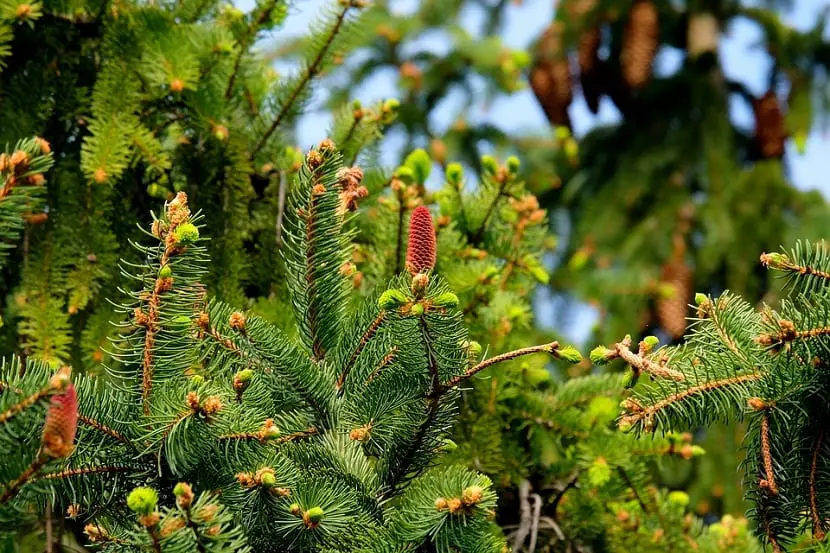
Conifers are seed plants of a type called cone or bearing and currently there are more than 550 species, which they are all trees or shrubsthus dominating forests in high latitudes with their evergreen needle-shaped leaves and, for example, pines, cedars, firs, spruces and redwoods, being the best known members of this family.
These are wind power plants, its seed develops within a protective cone which has as its name strobilus, being the time in which a cone can mature between about four months and three years, in addition to its size being highly variable.

There are coniferous seeds that are highly protected and can withstand extreme environmental conditionslike a lot of heat, great droughts and a lot of cold.
Shape and size of conifers
Commonly, conifers contain straight logsthey can have a great variety of sizes, being the largest and that is registered, the famous redwood giant standing over 375 feet (112,5m) tall, as opposed to smaller ones that typically don’t exceed ten inches (25cm)
What is the climate that conifers need?
Conifers dominate a terrestrial biome called taigaalso known as the boreal forest found in the northern hemisphere.
The largest biome in the world represents up to thirty percent of the world’s forestsits characteristic occurs with the numerous coniferous forests, covering most of the interior of Canada and Alaska in North America and much of Norway, Finland, Russia, Sweden and Japan in Eurasia.
Types of conifers
White fir

The white fir originates in central and southern Europe, it has a height of 60 metersgrowing very slowly in the first years, while when it is five years old, it can grow one meter per year and its flowering takes place during the spring.
Greek fir
As its name suggests, it originated in Greece, its leaves have a pointed shape of a dark grayish green color and usually in forestspreferring the sun or half shade.
Colorado fir

This fir has a very wide distribution area, in northern Mexico and the Southeastern United States, reaching up to Meters 30 and features a silver-gray hue.
This fir is characterized by its needles reaching 8 cm in length forming a brush, the cones of this fir are separated by sex on the same individual.
Red for
Also known as the Christmas treethis fir contains 40 widespread species from the regions of Asia, North Africa, Southern Europe and North America and is often confused by the way its leaves are attached to the branches.
Vancouver Fir

Better known as the giant spruce born in North America, it has a reddish-brown trunk at maturity, since the youngest have a grayish-green color and despite having a height of only 15m it is one of those that has rigid needle-like blades.
Korean for
Originated in the extreme south of Korea, this is one of the smallest fir trees that existwith a height ranging from 2 to 5 m.
It also grows very slowly, four to six inches a year until it reaches its mature cone shape, can be easily grown from seed.
Araucaria

The araucarias come from the island of Nordfolk, being a tree that it can reach 70 m in height and has a conical bearing.
It develops slowly, since the male cones are between 3.5-5 centimeters in length, while the female cones, wider at the base, are between 7.5-12.5 centimeters in length and 9-15 centimeters thick.
Its wood is quite hard, heavy and white and It is often used for the construction of sailboats for ships. It can also be planted in pots and grown as a small tree ornamentally.
Blue cedar
Its origin comes from North Africa, it contains blue-gray needles and of a fickle beauty, becoming one of the best options when it comes to decorating. It can reach a height of fifteen to twenty meters and it can be planted in any garden, you just have to make sure it has a large field in which it can develop
Juniper of La Miera

The family of this conifer is called cupressaceaethis can be found throughout the Mediterranean region, since it is a tree with a pointed and very branchy crown and despite knowing specimens of 20 m, this usually measures 3 to 5 metersit usually blooms in early spring and in its second year of growth a red berry fruit matures.
The wood that this tree contains is reddish, almost incorruptible, highly esteemed in cabinetmaking and it is also quite aromatic
Sabina Negral placeholder image
It is also known by names like Sabina suave, Sabina Negra, and Sabina mora.
It has a small Phoenician origin but is currently found in the Canary Islands, being a small shrub that it can reach up to 8 meters in heightwith a dense crown very similar to that of coniferous cypress.
Over the years, the trunk of this shrub can twist, but even if this happens, its wood is highly valued in carpentryin construction and cabinetmaking and like other conifers, this can also be multiplied with just the seed.
Tree of Life

Its name comes from “You“, what does it mean “Tree that produces resin” and although this is a small tree, since it does not exceed 12m in height, its trunk has thin bark, finely cracked and of a brown with scaly leaves in 4 specific very pointed rows.
The tree of life usually blooms in spring and it should be noted that the oil that comes off its trunk is poisonous.
